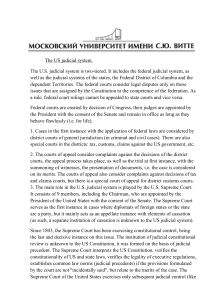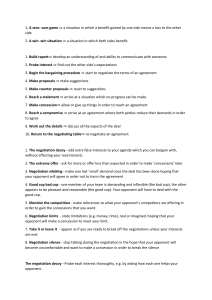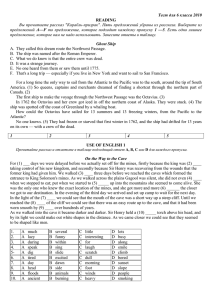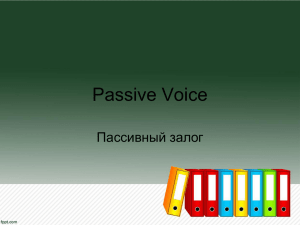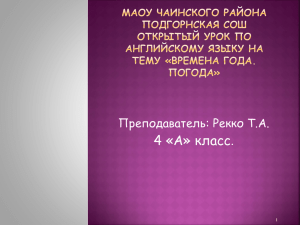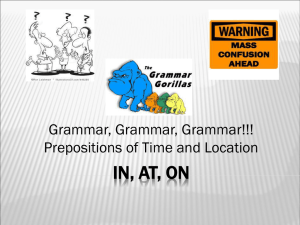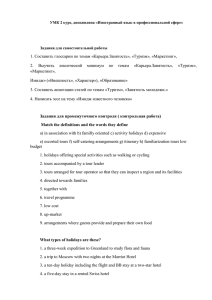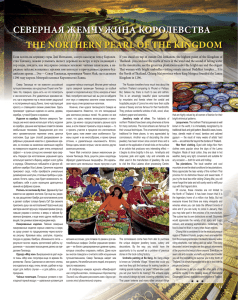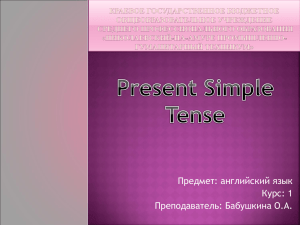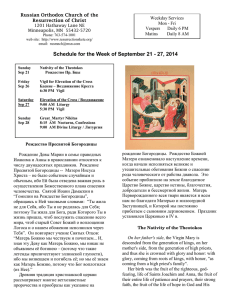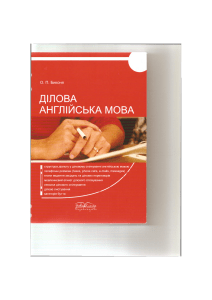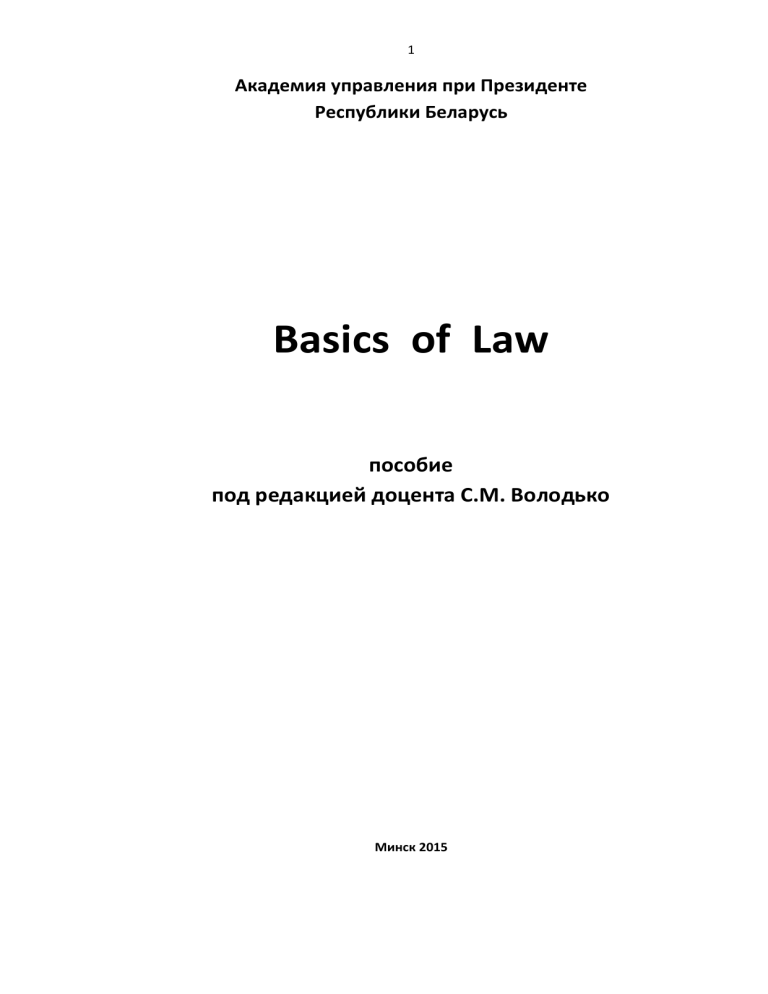
1 Академия управления при Президенте Республики Беларусь Basics of Law пособие под редакцией доцента С.М. Володько Минск 2015 2 Рецензенты: Доцент кафедры стилистики английского языка Минского государственного лингвистического университета, кандидат филологических наук Н.А. Копачева Доцент кафедры методики английского языка Минского государственного лингвистического университета, кандидат педагогических наук Л.А. Силкович Авторы: О.В. Соколовская, Е.А. Харченко, Е.А. Бахтадзе, И.Г. Луханина, Т.В. Кудрейко., В.В. Рогов, Т.В. Якимчук. под редакцией к.пед. наук, доцента С.М. Володько English for Law Students: пособие / О.В. Соколовская, Е.А. Харченко, Е.А. Бахтадзе, И.Г. Луханина, Т.В. Кудрейко., В.В. Рогов, Т.В. Якимчук ; под редакцией к.пед. наук, доц. С.М. Володько. – Мн.: Акад. упр. при Президенте Респ. Беларусь, 2015. – 130 с. Пособие по деловому английскому языку содержит аутентичные и адаптировнные тексты по проблемам права, словарь юридических терминов, комплекс лексических упражнений, предтекстовые, текстовые и послетекстовые упражнения для развития коммуникативных компетенций студентов в сфере устного и письменного профессионального общения. Пособие предназначено для студентов по специальности «Государственное управление и право», а также и для широкого круга лиц, использующих английский язык в своей практической деятельности и желающих усовершенствовать навыки владения английским языком в сфере государственного управления и юриспруденции. 3 Contents Preface (Предисловие)………………………………………… Unit 4 Judiciary………………………………………………….…. Unit 5 Specialised Courts (Tribunals) Unit 7 Negotiations…………………………………………….. Bibliography………………………………………………………….. 4 UNIT 4. JUDICIARY I. Anticipating the Issue Discuss your answers to the following questions. 1. What is the judicial system? What are its main functions? 2. What is the structure of courts in the Republic of Belarus? 3. What do you know about the UK judicial system? II. Legal Vocabulary List abolish – отменять, упразднять; to abolish a law – аннулировать / отменять закон; adjudicate – вынести приговор/судебное решение; to adjudicate on disputes – принимать решения по урегулированию споров; to adjudicate on a claim – выносить судебное решение по иску; appeal – апелляция, апелляционная жалоба; обжалование; подавать апелляционную жалобу; обжаловать; appeal process – апелляционное производство; судебный приказ о рассмотрении апелляции; application – применение (права, закона и т.д.); заявление; заявка; просьба, ходатайство; обращение; binding upon – обязательный для соблюдения; claim – требование; претензия; правопритязание; иск; требовать; заявлять претензию; притязать; заявлять право; claimant – истец; highvalue/small value claims –иски на крупную/мелкую сумму; case – судебное дело, случай в судебной практике; uncontested case судебный процесс без участия ответчика; admiralty case – дело, подлежащее рассмотрению по нормам адмиралтейского или морского права; charge – обвинять; to charge with an offence; contested wills – оспариваемые завещания; court procedure – судебная процедура, судопроизводство; defendant – ответчик, подсудимый, обвиняемый; guilt – вина, виновность; hear – разбирать, заслушивать, слушать; fair hearing – справедливое, беспристрастное разбирательство, слушание; impose a sentence – выносить приговор, назначать наказание; innocence – невиновность; 5 insolvency – неплатежеспособность; corporate / personal insolvency – неплатежеспособность частных и юридических лиц; judge – судить, выносить приговор, рассматривать дело в суде; district/circuit judge – судья местного/окружного суда; judicial review – судебный пересмотр/надзор; lay people – присяжные; legal action – судебный иск/дело/процесс; to take/bring a legal action – возбуждать судебное дело/предъявлять иск; to pursue a legal action against smb. – преследовать в судебном порядке; mortgage – закладная, ипотека; получать ссуду под недвижимость; offence – посягательство, преступление; procedural rule – процессуальная норма; proceeding – иск, обращение за судебной помощью; процессуальное действие; рассмотрение дела в суде, судебное разбирательство, процесс; судебное преследование; appeal proceedings – апелляционное производство; reassess – подвергать пересмотру, повторно рассматривать; sentence – приговор, судебное решение; приговаривать, осуждать; tort – гражданское правонарушение, деликт; III. Vocabulary Reinforcement A. Word Meaning Match the words with their definitions. appeal, n revise or renew one’s assessment adjudicate, v a judicial proceeding brought by one party against another abolish, v the power of a court to adjudicate the constitutionality of the laws of a government or the acts of a governmental official proceedings, n make an official judgment or decision insolvency, n a legal declaration of how a person wishes his possessions to be disposed of after death tort, n an application or proceeding for review by a higher court reassess, v a legal action taken against someone will, n inability to pay bills or debts 6 legal action, n judicial review, n B. Word Families Complete the chart. Verb claim abolish hear a wrongful act for which the injured party may bring a civil suit put an end to sth Adjective Noun imposing reassessment apply appeal proceeding judicial contest C. Word Groups Match the words and word combinations with similar meanings. uncontested a wrongful act binding conviction, verdict bring a legal action jurors lay people suit, proceeding juvenile enforce claimant obligatory, compulsory tort crime, law-breaking case start a legal procedure impose not disputed, agreed upon mortgage plaintiff offence intended for young people sentence a loan of money D. Word Fields Which of the words and phrases below are associated with the following: 1) civil courts, 2) criminal courts? 7 Disputes between landlords and tenants; the Magistrates Courts; serious offences; life imprisonment; fine; a County Court; uncontested cases; smallvalue claims; divorce cases; contract and tort cases; lay magistrates; capital punishment; to judge the guilt or innocence; jury. E. Word Usage 1. Distinguishing meaning. Which word in each line is the odd one out? You may need to consult a dictionary to distinguish the differences in meaning. jury panel lay people judge impartial unprejudiced unfair unbiased remove abolish eliminate settle appeal apply use employ conviction fine sentence verdict impose enforce exempt implement adjudicate challenge arbitrate judge IV. Background Reading Look at the heading of the text. What issues do you think the text contains? Write a list of 5 questions that you think will be answered in the text. Then read the text and determine whether your questions are answered. JUDICIARY IN THE UK In all legal systems there are institutions for creating, modifying, abolishing and applying the law. Usually these take the form of a hierarchy of courts. The role of each court and its capacity to make decisions is strictly defined in relation to other courts. There are two main reasons for having a variety of courts. One is that a particular court can specialize in particular kinds of legal action – for example, family courts and juvenile courts. The other is so that a person who feels his case was not fairly treated in a lower court can appeal to a higher court for reassessment. The decisions of a higher court are binding upon lower courts. At the top of the hierarchy is a supreme lawmaking body, but the process of taking an action from a lower court to the highest court may be very time-consuming and costly. For historical reasons, as a state made up of several separate jurisdictions, the UK does not have a single unified legal system. Instead, there is one system for England and Wales, another for Scotland, and a third for Northern Ireland. In England, Wales and Northern Ireland the court system is headed by the Supreme Court, consisting of the Court of Appeal, the High Court of 8 Justice (for civil cases) and the Crown Court (for criminal cases). In Scotland the chief courts are the Court of Session (for civil cases) and the High Court of Justiciary (for criminal cases). Sheriff courts have no equivalent outside Scotland as these courts deal both with criminal and civil caseloads. A feature common to the system of law in the UK is that there is no complete code. The cases are decided basing on precedent that is previous legal decisions. For centuries the House of Lords had been the highest court in the land for all criminal and civil cases in England, Wales and Northern Ireland, and for all civil cases in Scotland, but in October 2009 it was replaced by the new Supreme Court of the UK. It is the final court of appeal consisting of 12 judges appointed by the Monarch and it hears cases of the greatest public or constitutional importance affecting the whole population. We can use the English legal system administered by the courts in England and Wales as an example of how courts relate to one another. The main division is between the criminal and civil courts. Besides, there are many special tribunals, for example, industrial tribunals dealing with labour disputes. The Civil Courts. Civil actions take place between two or more individuals in dispute. These disputes can take many forms, for example between neighbours, families, companies, consumers and manufacturers. It is the function of the civil courts to adjudicate on these disputes. The lowest court in a civil action is a County Court, of which there is one in every town in England and Wales. There are some 250 county courts. The judges are always professionals. Each court is assigned at least one circuit judge and one district judge. The circuit judge usually hears the high-value claims and matters of greater importance or complexity. The district judge hears uncontested cases and small-value claims. The jurisdiction of the County Courts covers actions founded upon contract and tort; trust and mortgage cases; action for the recovery of land, disputes between landlords and tenants, complaints about race and sex discrimination, admiralty and patent cases, divorce and other family matters. The general limit in such cases is 25,000 pounds. Cases involving larger amounts of money are heard by one of the divisions of the High Court. This court has unlimited civil jurisdiction and consists of three branches: 9 the Queen’s Bench Division, which is concerned with contract and tort cases, and deals with applications for judicial review; the Chancery Division, which deals with corporate and personal insolvency, disputes in the running of companies, between landlords and tenants and in intellectual property matters, and the interpretation of trusts and contested wills; the Family Division, which is concerned with family law, including adoption and divorce. Appeals from the High Court and county courts are heard in the Court of Appeal. It normally consists of three judges. Each one delivers a judgment, and the majority opinion prevails. The Court has the power to order a new trial or the reversal or variation of a judgment. The Criminal Courts There are two main types of criminal courts: the Magistrates’ Courts (or courts of first instance), and the Crown Courts. The Magistrates’ Courts deal with about 95 per cent of all criminal cases. Every person charged with an offence is summoned to appear before a local magistrates’ court, which may impose a fine up to a general limit of £2,000 or 12 months’ imprisonment. The Magistrates’ Courts may refer cases requiring a heavier penalty to the Crown Court. There are about 700 Magistrates’ Courts in England and Wales, served by lay magistrates or Justices of the Peace. They are ordinary but worthy citizens who have been appointed to their positions for their good reputation, often with the support of political parties. These people are not legally qualified but receive some basic training in court procedures. There are 28,000 JPs in England. Each of them works in the court about 30-50 days a year. The most serious crimes such as murder, rape, armed robbery, fraud and so on are tried and sentenced in the Crown Court. It sits at about 90 centres and is presided over by the High Court judges. All contested trials take place before a jury. There are twelve jurors. These are ordinary members of the public between the ages of 18 and 70 who are selected at random. They are not paid but are given expenses while they are on jury service. It is not necessary for a juror to know anything about the law. Indeed certain people connected with the world of law, such as solicitors, are not allowed to serve as jurors. The main function of the jury is to listen to the case and to judge the guilt or innocence of the defendant. 10 A person convicted in a Magistrates’ Court may appeal against its decision to the Crown Court. An appeal against a decision of the Crown Court may be taken to the Court of Appeal, but it is seldom successful. Judges in the Court of Appeal may confirm, reverse or vary the original sentence. Occasionally, a case is carried through this system of appeal all the way to the Supreme Court of the UK. In Great Britain most court cases are open to the public. This means that any member of the public may witness a court case. But there are some proceedings which are closed. V. Reading Comprehension A. Reading for the Main Idea Read the text to understand the main idea of it and do the following tasks. 1. Think of a statement that best summarises the main idea of the text. 2. What information in the field of the judiciary in the UK is of primary importance or new to you? B. Reading for Details Read the text again to understand details and do the following tasks. 1. What do the following numbers refer to in the text? 250; 700; £2,000; 18; 70; 95%; £25,000; 2009; 12; 28,000; 90. 2. Match the words to make word partnerships from the text. to appeal jurisdiction lay expenses civil in court procedures legal cases give caseloads impose at random training for reassessment uncontested magistrates criminal and civil a fine to be selected action 3. Understanding Expressions: give the best explanation for each of these phrases used in the text. To adjudicate on disputes; to impose a sentence; court procedures; serious offences; a hierarchy of courts; legal action; to appeal for reassessment; time- 11 consuming; Justices of the Peace; to be selected at random; to be given expenses; to judge the guilt or innocence; to reverse the original sentence; closed and open proceedings; a unified legal system; uncontested cases; admiralty and patent cases; judicial review; corporate and personal insolvency; landlords and tenants; contested wills. 4. Complete: use an appropriate preposition where necessary. to(2), on, upon, for (2), with (2), at, before, of (2), in 1. The High Court has jurisdiction to adjudicate … murder cases. 2. The jury listens … the case and judges … the guilt or innocence … the defendant. 3. A person who feels his case was not fairly treated in a lower court can appeal … a higher court … reassessment. 4. The Queen’s Bench Division deals … applications … judicial review. 5. The jurors are selected … random. 6. A person charged … an offence is summoned to appear … a local magistrates’ court. 7. The decisions of a higher court are binding … lower courts. 8. Justices … the peace get some basic training … court procedures. 5. Translate: give the English equivalents for the following word combinations. Оспариваемые завещания; обжалование; выносить судебное решение по иску; судебный процесс без участия ответчика; обязательный для соблюдения; назначать наказание; отменять закон; судопроизводство; принимать решения по урегулированию споров; неплатежеспособность частных и юридических лиц; присяжные; судья местного/окружного суда; повторно рассматривать; преступление; гражданское правонарушение; судебное дело; возбуждать судебное дело/предъявлять иск; апелляционное производство; судебный пересмотр/надзор; иски на крупную/мелкую сумму; виновность/невиновность подсудимого; 6. Linking: match the first half of each sentence with the most appropriate second half. 1. The Supreme Court of the United a) lay magistrates or Justices of the Kingdom… Peace. 2. The lowest court in a civil action is.. b) family law, including adoption 12 and divorce. 3. The circuit judge usually hears … c) is the final court of appeal. 4. The district judge hears … d) the high-value claims. 5. The High Court … e) the Court of Appeal. 6. The Magistrates’ Courts in England f) uncontested cases and small-value and Wales are served by … claims. 7. An appeal against a decision of the g) a County Court. Crown Court may be taken to … 8. The Family Division is concerned h) disputes in the running of with … companies, between landlords and tenants and in intellectual property matters. 9. The Chancery Division deals with … i) consists of three branches. 10. The Queen’s Bench Division is j) contract and tort cases, concerned with … applications for judicial review. 7. Complete: use appropriate information from the text to finish the following sentences. 1. There are two main reasons for having … 2. In England, Wales and Northern Ireland the court system is … 3. In Scotland the chief courts are … 4. The Supreme Court of the United Kingdom … 5. Civil actions take place … 6. The jurisdiction of the County Courts covers … 7. The High Court consists of … 8. The Magistrates’ Courts deal with … 9. The most serious crimes are tried … 10. The main function of the jury is … 8. According to the text, mark these statements T (true) or F (false). Use the conversational phrases: «as far as I know», «I’m of the same opinion», «on the contrary», etc. 1. The decisions of a lower court are binding upon higher courts. 2. A feature common to the system of law in the UK is that there is no complete code. 3. The district judge of a County Court usually hears the high-value claims. 4. Admiralty and patent cases are heard by the Queen’s Bench Division of the 13 High Court. 5. The Chancery Division deals with corporate and personal insolvency, disputes between landlords and tenants and intellectual property matters. 6. The lowest court in a civil action is a Magistrates’ Court. 7. Lay magistrates are ordinary citizens chosen from the community. 8. A person convicted in a Magistrates’ Court may not appeal against its decision. 9. In Great Britain most court cases are open to the public. 10. The High Court hears cases of the greatest public or constitutional importance affecting the whole population. 9. Translate the following sentences into English. 1. Верховный суд Англии и Уэльса, возглавляемый в качестве председателя лорд-канцлером, включает в себя три самостоятельных судебных учреждения – Апелляционный суд, Высокий суд и Суд короны. 2. Суды магистратов – суды низшей инстанции, состоящие из мировых судей, которые в большинстве случаев не являются профессиональными юристами и не получают материального вознаграждения за свою деятельность. 3. Суд короны рассматривает в основном уголовные дела о тяжких преступлениях, а в качестве апелляционной инстанции – жалобы от лиц, осужденных в судах магистратов. 4. Присяжные заседатели избираются наугад, ими может быть любой гражданин Великобритании в возрасте от 18 до 70 лет. 5. В настоящее время 95% всех гражданских исков рассматривается в судах графств. 6. Суды магистратов рассматривают уголовные дела о мелких преступлениях, а также споры на незначительную сумму иска и семейные дела. 7. По окончании судебного разбирательства, которым руководит судья, жюри присяжных, удалившись на совещание, должно вынести вердикт, который должен содержать ответ на вопрос: виновен или невиновен подсудимый в совершении преступления. 10. Give profound answers to the following questions. 1. What are the main reasons for having a variety of courts? 14 2. 3. 4. 5. 6. 7. 8. 9. Is there a single unified legal system in the United Kingdom? What are the functions of the Civil Courts? What does the jurisdiction of the County Courts cover? What divisions does the High Court consist of? What cases does each of the divisions examine? What do the Magistrates’ Courts deal with? What cases are heard in the Crown Court? Who is eligible for jury service in England? What is the highest court of the country? VI. Supplementary Reading Read the texts to learn more about the problem under discussion. THE JURY The use of the jury in English law stretches far into history. Juries probably began to be used there after the Norman Conquest in 1066. By the 1400’s they were used in almost all cases to determine guilt. Until the mid 1900’s, however, jurors were chosen only from citizens who were property owners and there was no age limit. Jurors were often not representative of the population as a whole. During the 1960’s, most countries introduced laws allowing all citizens of voting age, but below a specific age limit, to qualify for jury service. In jury trials the judge decides questions of law, sums up the evidence for the jury and instructs it on the relevant law and discharges the accused or passes sentence. Only the jury decides whether the defendant is guilty or not guilty. In England and Wales, if the jury cannot reach a unanimous verdict, the judge may direct it to bring in a majority verdict provided that, in the normal jury of 12 people, there are not more than two dissentients. In Scotland, where the jury consists of 15 people, the verdict may be reached by a simple majority, but as a general rule, no person may be convicted without corroborated evidence. If the jury returns a verdict of ‘not guilty’ (or in Scotland ‘not proven’, which is an alternative verdict of acquittal), the prosecution has no right of appeal and the defendant cannot be tried again for the same offence. In the event of a ‘guilty’ verdict, the defendant has a right of appeal to the appropriate court. A jury is completely independent of the judiciary. Any attempt to interfere with a jury once it is sworn in is punishable under the Contempt of Court Act 1981. Although the right of the defence to challenge up to three potential members of a jury without giving any reason is to be abolished in England and 15 Wales, it will remain open to both parties to challenge potential jurors by giving reasons where they believe that an individual juror is likely to be biased. Around 200,000 people between the ages of 18 and 65 perform jury service each year. All of them are selected entirely at random from the electoral register to perform this important role. Ineligible persons include the judiciary, priests, people who have within the previous ten years been members of the legal profession, the Lord Chancellor’s Department, or the police, prison and probation services, and certain sufferers from mental illness. Persons disqualified from jury service include those who have, within the previous ten years, served any part of a sentence of imprisonment, youth custody or detention, or been subject to a community service order, or, within the previous five years, been placed on probation. Anyone who has been sentenced to five or more years’ imprisonment is disqualified for life. THE COURT SYSTEM IN THE USA The U.S. court system is divided into two administratively separate systems: the federal and the state, each of which is independent of the executive and legislative branches of government. The Federal Court System Of the two systems, the federal one is by far the less complicated. It is divided into three main levels. At the bottom are the federal district courts, which have original jurisdiction in most cases of federal law. Made up of 92 districts, the federal district court system has at least one bench in each of the 50 states. There are from 1 to more than 20 judges in each district who are appointed by the President and serve for life. Cases handled by these courts include those relating to alleged violations of the constitution or other federal laws, maritime disputes, cases directly involving a state or the federal government, and cases in which foreign governments or citizens of foreign countries are involved. Directly above the district courts are the U.S. courts of appeals. Established by the Congress in 1891, the court of appeals system is composed of 11 judicial circuits throughout the 50 states. The highest court in the federal system is the Supreme Court of the United States. Since 1869 it has been composed of one chief justice and eight associate justices. It sits in Washington and has final jurisdiction on all cases it hears. It may review decisions made by the U.S. courts of appeals and it may also choose to hear appeals from state appellate courts. 16 In addition, the federal judiciary maintains a group of courts that handle certain limited types of disputes. Included among such special federal courts are the Court of Federal Claims, which adjudicates monetary claims against the U.S. government, and the Tax Court. State Court Systems The system of state courts is quite diverse: virtually no two states have identical judiciaries. In general, however, the states have a hierarchically organized system of general courts along with a group of special courts. The lowest level of state courts may include any of the following: magistrate court, municipal court, justice of the peace court, police court, traffic court and county court. Such tribunals, often quite informal, handle only minor civil and criminal cases. More serious offenses are heard in superior court, also known as state district court. The superior courts hear appeals from the inferior courts and have original jurisdiction over major civil suits and serious crimes. It is here that most of the nation’s jury trials occur. The highest state court, usually called the appellate court, generally hears appeals from the state superior courts. Additionally, a state may have any of a wide variety of special tribunals, usually on the inferior court level, including juvenile court, divorce court, probate court, family court, housing court, and small-claims court. In all, there are more than 1,000 state courts of various types. VIII. Text Rendering Render the following text in English. СУД ПРИСЯЖНЫХ В БЕЛАРУСИ: «ЗА» И «ПРОТИВ» Нужен ли в стране институт присяжных заседателей? Рассуждать об этом можно долго, приводя различные доводы «за» и «против». Эта тема была особенно актуальна и на недавнем заседании Совета по вопросам правовой и судебной деятельности при Президенте. Члены совета уверены, что участие народных представителей в судебных процессах расширять нужно. Идею же суда присяжных для нашей страны пока сочли преждевременной. Да и опыт иностранных государств показывает, что восприятие суда присяжных в обществе, а также среди юристов и ученых неоднозначно. В пользу этого института говорят, к примеру, его положительное влияние на укрепление независимости правосудия, развитие принципа состязательности и повышение профессионализма уголовной юстиции. К тому же участие 17 народных представителей – это еще и гарантия права человека, обвиняемого в совершении преступления, на рассмотрение дела независимым, коллегиальным судом. Основным же недостатком такой формы судопроизводства называют громоздкость, нестабильность в принятии решений. Введение суда присяжных приведет к существенному изменению уголовного процесса, усложнению судопроизводства и увеличению сроков рассмотрения дел в суде. Эти и другие причины заставляют многие страны постепенно сужать компетенцию суда присяжных. В классической форме он все же более характерен для стран англосаксонской системы права и не вполне совместим с существующим в Беларуси уголовно–процессуальным правом. Наша судебная система, предусматривающая участие народных заседателей при рассмотрении тяжб по уголовным делам, и без того достаточно эффективна. И защищает права и интересы как обвиняемых, так и потерпевших. Поэтому пока в этом вопросе решено все оставить без изменений. А вот институт народных заседателей однозначно планируется развивать, к примеру, через повышение уровня их правовой подготовки, совершенствование порядка подбора кандидатов в народные заседатели. /Советская Белоруссия №68 (24451). Пятница, 2. Work in pairs and discuss the following. 11 апреля 2014 года./ 18 1) Which courts do you think would deal with: a bank robbery, a divorce case, a burglary committed by a fifteen-year-old, murder, theft, speeding, armed robbery, smuggling, white collar crime, pick pocketing robbery, blackmail, domestic violence, drunk driving, shoplifting, drug trafficking, terrorism, vandalism, fraud, hijacking, kidnapping, arson, child abuse, identity theft, embezzlement. 2) Supposing you were a judge, what type of punishment would you impose for the crimes mentioned above: traffic ticket, license suspension, fine, house arrest, community service, jail time, life imprisonment, capital punishment? Give your reasons. UNIT 5. SPECIALISED COURTS (TRIBUNALS) I. Anticipating the Issue Discuss your answers to the following questions. 1. What is the meaning of the word трибунал in Russian? 2. What is the Belarusian conception of specialised courts? II. Legal Vocabulary List ad hoc – специальный, устроенный для данной цели, для данного случая; akin – родственный, близкий, родной; appeal – апелляция, апелляционная жалоба; обжалование; подавать апелляционную жалобу; обжаловать; argument – довод, аргумент, доказательство; award – присуждать, назначать; chair – председательствовать, вести собрание, возглавлять; claim – требование; претензия; правопритязание; иск; требовать; compensation – компенсационные выплаты, возмещение; cross-examine – подвергать перекрёстному допросу; disclosure – обнаружение, открытие, разоблачение, раскрытие; dispute – спор, разногласия; evidence – улика;свидетельское показание; hearing – разбор, слушание дела; hearsay evidence – доказательства, основанные на слухах; показания с чужих слов; impose a fine – налагать штраф; laypeople – присяжные; 19 Lord Chancellor – лорд-канцлер (глава судебного ведомства и верховный судья Англии, председатель палаты лордов и одного из отделений Верховного суда); oath – клятва, присяга; panel – коллегия присяжных (заседателей); penalty – наказание, взыскание, штраф; resolve – решать, принимать решение, постановлять; statutory – установленный, предписанный (законом); supervision – надзор, наблюдение, заведование, контроль; tribunal – орган правосудия; судебное или арбитражное учреждение; суд; трибунал; witness – cвидетель (в суде); заявлять претензию; притязать; заявлять право. III. Vocabulary Reinforcement A. Word Meaning Match the words with their definitions. panel, n question (a witness called by the other party) in a court of law to discredit or undercut testimony already given cross-examine, v a court of justice hearing, n act as chairperson of or preside over disclosure, n an opportunity to state one's case dispute, n the action of making new or secret information known award, v a punishment imposed for breaking a law, rule, or contract chair,v a sworn declaration that one will tell the truth penalty, n give or order the giving of sth as an official payment, compensation, or prize oath, n a small group of people brought together to discuss, investigate, or decide on a particular matter tribunal, n a disagreement, argument, or debate statutory, adj (of a criminal offence) carrying a penalty prescribed by statute Complete the chart. Verb disclose Adjective Noun 20 impose compensation statutory argument evident appeal fine witness supervision C. Word Groups Match the words with similar meanings. chair pretension appeal give dispute proof, reasoning claim tax award request argument decide, determine, settle impose see resolve disagreement, debate oath punishment penalty testimony witness vow evidence preside D. Word Fields Which of the words and phrases below are associated with the following: 1) tribunal hearings, 2) tribunal decisions? Panel; disclosure rules; to impose fines; to resolve claims; majority decision; to resolve the issue; to award compensation; written decision; to cross-examine witnesses; non-legally qualified parties; clarification. E. Word Usage 1. Distinguishing meaning. Which word in each line is the odd one out? You may need to consult a dictionary to distinguish the differences in meaning. judge Supreme Court magistrate’s court tribunal fine compensation prize penalty 21 award similar testimony witness discussion loan akin proof see punishment verdict different evidence arrest debate decision close request notice argument IV. Background Reading Read the following text. Focus on the meaning of the boldfaced words. Determine whether what you anticipated coincides with the information of the text. TRIBUNALS The tribunal system of the United Kingdom is part of the national system of administrative justice with tribunals classed as non-departmental public bodies (NDPBs). Though it has grown up on an ad hoc basis since the beginning of the twentieth century, from 2007 reforms were put in place to build a unified system with recognised judicial authority, routes of appeal and regulatory supervision. Tribunals are a specialised group of judicial bodies, akin to courts of law. They are normally set up under statutory powers, which also govern their constitution, functions and procedure. Tribunals often consist of lay people, but they are generally chaired by a legally qualified person. They tend to be less expensive, and less formal, than courts of law. Some tribunals settle disputes between private citizens. Industrial tribunals, for example, play a major role in employment disputes. Others, such as those concerned with social security, resolve claims by private citizens against public authorities. A further group, including tax tribunals, decides disputed claims by public authorities against private citizens. Tribunals usually consist of an uneven number of people so that a majority decision can be reached. Members are normally appointed by the government minister concerned with the subject, although the Lord Chancellor (or Lord President of the Court of Session in Scotland) makes most appointments when a lawyer chairman or member is required. In many cases there is a right of appeal to a higher tribunal and, usually, to the courts. Tribunals do not normally employ staff or spend money themselves, but their expenses are paid by the government departments concerned. An independent Council on Tribunals exercises general 22 supervision over many tribunals. The UK tribunal system is headed by the Senior President of Tribunals. Tribunal hearings Tribunals usually sit as a panel, incorporating a legally qualified tribunal chairman, as well as panel members with specific areas of expertise. They hear evidence from witnesses but decide the case themselves. Tribunals have limited powers (depending on the jurisdiction of the case) to impose fines and penalties or to award compensation and costs. Other types of tribunal decisions might result in the allowance or disallowance of a benefit; leave or refusal to stay in the UK or about the provision of special educational help for school age children. Many cases involve individuals putting their own case, without legal assistance, so the system needs to be accessible to all. Tribunal judges often help to ensure this, by guiding non-legally qualified parties through the necessary procedures, if necessary. There are many different tribunals, covering a wide range of different areas affecting day-to-day life. Before the hearing Before the hearing begins, the Tribunal Judge chairing the hearing reads the papers in the case and considers how to proceed when the hearing begins. Tribunal judges play an active role in managing tribunal cases once issued, helping to ensure they proceed as quickly and efficiently as possible. The hearing Except in cases, which involve national security or evidence of a very personal nature, tribunal cases are held in public. In many cases, no oath will be administered, and hearsay evidence can be considered. Proceedings are relatively informal and nobody wears robes or wigs. Parties are expected to assist by following directions and providing enough copies of their relevant documents in good time, but the stricter disclosure rules for the ordinary courts may not be applied. Occasionally, the parties will have agreed the relevant facts and it will not be necessary for the judge to hear oral evidence. The issues may concern the law to be applied or the terms of the decision or judgment to be given. However, more often than not, the parties will give written and oral evidence and their witnesses may be cross-examined (asked questions by the other party) to test their evidence against the other party’s case. 23 The Tribunal Judge ensures that all parties have their case presented and considered as fully and fairly as possible. During the case, the Tribunal Judge or the panel members may ask questions on any point that needs clarification or which will help with his or her decision. The Tribunal Judge also decides on all matters of procedure, which may arise during a hearing. The Tribunal Judge and panel members (if a panel hears the case) will consider the evidence. They are guided and constrained by the statutory powers of their Tribunal to resolve the issue, which the claimant has raised. If the case meets the requirements of the statute, the Tribunal can make one of a range of orders set out in the law. The Tribunal will then hear closing arguments (submissions) from both parties, and make its decision. The decision Tribunal Chairmen or Tribunal Judges may be assisted in their decisionmaking by other legally qualified members, or by experienced specialist panel members. Specialist members do not act as expert witnesses but bring to the panel their experience of their particular field. All legal matters remain the Tribunal Judge’s responsibility. All of the panel members take part in the decision. The Tribunal’s decision is given either at the hearing, or in writing later. In either case, the parties will get a written decision. V. Reading Comprehension A. Reading for the Main Idea Read the text to understand the main idea of it and do the following tasks. 1. Think of a statement that best summarises the main idea of the text. 2. Answer the following questions. 1. What cases are tribunals concerned with? 2. What powers do tribunals have? 3. What are the responsibilities of the Tribunal Judge? B. Reading for Details Read the text again to understand details and do the following tasks. 1. Understanding Expressions: give the best explanation for each of these phrases used in the text. The tribunal system of the United Kingdom; non-departmental public bodies; 24 on an ad hoc basis; regulatory supervision; routes of appeal; lay people; industrial tribunals; employment disputes; social security; a majority decision; legal assistance; legally qualified; to impose fines; to award compensation; hearsay evidence; disclosure rules; cross-examination of witnesses; panel members; expert witnesses; to resolve the issue; closing arguments; a written decision. 2. Complete: use an appropriate preposition where necessary. at, on(2), in(4), with, under, between, from, of(5) 1. The tribunal system … the United Kingdom is part … the national system … administrative justice … tribunals classed as nondepartmental public bodies (NDPBs). 2. Tribunals are normally set up … statutory powers, which also govern their constitution, functions and procedure. 3. Some tribunals settle disputes … private citizens. 4. Except … cases, which involve national security or evidence … a very personal nature, tribunal cases are held … public. 5. The Tribunal Judge also decides … all matters … procedure, which may arise during a hearing. 6. Tribunal judges play an active role … managing tribunal cases once issued. 7. The Tribunal will then hear closing arguments … both parties, and make its decision. 8. The Tribunal Judge or the panel members may ask questions … any point that needs clarification. 9. The Tribunal’s decision is given either … the hearing, or … writing later. 3. Translate: give the English equivalents for the following word combinations. Национальная система административного правосудия; на специализированной основе; предусмотренные законом полномочия; урегулировать споры; промышленные суды; разрешать споры между гражданами и государственными органами; налагать штраф; присяга; доказательства, основанные на слухах; перекрестный допрос свидетелей; правила разглашения; устное свидетельство; мантии и парики; члены суда присяжных; рассматривать свидетельство; заключительные доводы 25 сторон; имеющий юридическое образование; принимать решение большинством голосов; регулирующий контроль; лорд-канцлер; присудить возмещение нанесенного вреда. 4. Linking: match the first half of each sentence with the most appropriate second half. 1. Tribunals are a specialised group of a) the Tribunal Judge reads the judicial bodies, … papers in the case. 2. Some tribunals settle disputes … b) nobody wears robes or wigs. 3. Industrial tribunals play a major c) on all matters of procedure. role … 4. Before the hearing begins, … d) but decide the case themselves. 5. Tribunals hear evidence from e) to test their evidence against witnesses … the other party’s case. 6. Proceedings are relatively informal f) and make its decision. and … 7. The Tribunal Judge also decides … g) the parties will get a written decision. 8. Witnesses may be cross-examined h) akin to courts of law. … 9. The Tribunal will then hear closing i) in employment disputes. arguments from both parties, … j) between private citizens. 10. The Tribunal’s decision is given either at the hearing or … 5. Complete: use appropriate information from the text to finish the following sentences. 1. The tribunal system of the United Kingdom is … 2. Tribunals often consist of lay people … 3. Tribunals usually consist of an uneven number of people … 4. The Tribunal Judge ensures that … 5. During the case, the Tribunal Judge or the panel members may ask questions on… 6. If the case meets the requirements of the statute, … 7. Tribunal Chairmen or Tribunal Judges may be assisted in their decisionmaking by … 8. All legal matters at tribunals remain the responsibility of … 26 6. According to the text mark these statements T (true) or F (false). 1 Tribunals are a specialised group of judicial bodies, akin to courts of law. 2. Tribunals often consist of lay people, but they are not chaired by a legally qualified person. 3. Tribunals usually consist of an even number of people. 4. The Lord Chancellor makes most appointments when a lawyer chairman or member is required. 5. In many cases, an oath will be administered, and hearsay evidence cannot be considered. 6. The Tribunal Judge decides on all matters of procedure, which may arise during a hearing. 7. Proceedings are very formal and judges wear robes or wigs. 8. The parties will give written and oral evidence and their witnesses may be cross-examined. 9. All legal matters remain the responsibility of the panel members. 7. Give the best definition for the following legal terms. Lay people; to impose a fine; hearsay evidence; disclosure rules; the statutory powers; a hearing; an appeal. 8. Translate the following sentences into English. 1. В Англии слово «трибунал» обычно используют для наименования специальных судов, созданных для решения отдельных вопросов, часто – для рассмотрения апелляций на решения разных государственных органов. 2. Членами трибунала могут быть не только юристы, но и лица, имеющие специальные знания в той сфере деятельности, которой занимается трибунал. 3. Cпоры между администрацией и гражданами рассматривают как общие суды, так и специально созданные органы административной юстиции – административные трибуналы, которые также имеют свои высшие инстанции. 4. Традиционно административные трибуналы подразделяются на две большие группы: трибуналы в области управления экономикой (налоговые, промышленные, земельные, суд по рассмотрению жалоб на ограничение свободы промысла, свободы предпринимательства, 27 апелляционный, транспортные, лесные) и трибуналы в сфере социального управления. 5. Aдминистративные трибуналы делятся также на две группы: трибуналы, членами которых являются лица, назначаемые Лордканцлером, и трибуналы, членами которых являются лица, назначаемые соответствующими министрами. 6. Процедура рассмотрения споров административными трибуналами устанавливается специальными положениями и регламентами, которые принимаются административными органами. 9. Give profound answers to the following questions. 1. What is the place of tribunals in the judicial system of the UK? 2. What people do tribunals consist of? 3. What kind of disputes do tribunals settle? 4. What powers do tribunals have? 5. What does the Tribunal Judge have to do before the hearing begins? 6. What are tribunal proceedings like? 7. How is the Tribunal’s decision made? VI. Supplementary Reading Read the text to learn moreabout the problem under discussion. USA SPECIALISZED FEDERAL COURTS Congress has created a number of courts in the federal system that have specialized jurisdiction. Unlike constitutional courts, judges appointed to legislative courts do not enjoy lifetime tenure, unless Congress specifically authorized a life term. Moreover, judges in legislative courts do not enjoy the Constitutional prohibition against salary reductions of judges. A summary of these courts is as follows: The United States Court of Appeals for the Armed Forces reviews court martial convictions from the armed forces. Only the Supreme Court of the United States can review its cases. Judges sitting on this court enjoy neither life tenure nor protection against salary reduction. The United States Court of Federal Claims has jurisdiction to hear a broad range of claims brought against the United States. The court was called the United States Claims Court from 1982 to 1992. Many cases brought before this tribunal are tax cases, though the court also hears cases involving litigants who were federal employees and other parties 28 with monetary claims against the United States. Judges sitting on this court enjoy neither life tenure nor protection against salary reduction. An adverse decision in this court is appealed to the United States Court of Appeals for the Federal Circuit. The United States Court of International Trade has jurisdiction to hear cases involving customs, unfair import practices, and other issues regarding international trade. This court is a constitutional court, so its judges have lifetime tenure and protection against salary reduction. The United States Court of Appeals for Veterans Claims reviews decisions of the Board of Veteran Appeals. Appointments of judges last 15 years. An adverse decision in this court is appealed to the United States Court of Appeals for the Federal Circuit. The United States Tax Court is a legislative court that resolves disputes between citizens and the Internal Revenue Service. Appointments of judges last 15 years. Adverse decisions are appealed to a court of appeals in an appropriate regional circuit. VIII. Text Rendering Render the following text in English. Специализированные суды для рассмотрения трудовых споров в различных странах, несмотря на то, что имеют одинаковое название, по юрисдикции, процедуре, составу и полномочиям несколько различаются. Учреждения специальной трудовой юстиции давно существуют на Западе (во Франции, например, с 1806 г.) и накопили огромный опыт в разрешении трудовых споров. Зарубежный опыт свидетельствует о том, что трудовые суды выполняют важные задачи по применению трудового права. Судебные дела рассматривает коллегия в составе профессионального судьи и двух непрофессиональных судей, выдвигаемых профессиональными союзами и организациями предпринимателей. Такой состав суда призван обеспечить всестороннее беспристрастное разбирательство спора и принятие справедливого решения. Большое значение имеет и то, что трудовые суды могут обеспечить квалифицированное рассмотрение дела, поскольку профессиональные судьи таких судов – юристы, специализирующиеся в области трудового 29 права, а непрофессиональные судьи – практики, хорошо ориентирующиеся в вопросах труда и трудовых отношений. Трудовые суды обычно встроены в общую судебную систему, и лишь две страны – ФРГ и Израиль – имеют полностью автономную систему трудовых судов, наделенных широкой юрисдикцией. Сфера компетенции трудовых судов – юридические споры (конфликты права) – требуют особо тщательного соблюдения судебной процедуры, всесторонности и взвешенности оценок, учета многих формально-юридических моментов. Деятельность судов по трудовым делам в различных странах привела к процессуальным нововведениям, к формированию процедур, присущих именно трудовой юстиции. Как правило, трудовые суды функционируют на основе правил и процедур, закрепленных в гражданском процессуальном законодательстве. Но в этот принцип внесены определенные поправки: процедура в трудовых судах более быстрая и менее дорогостоящая, чем в обычных судах; отсутствуют некоторые формальности, присущие гражданскому процессу; суды проявляют большую инициативу в ведении судебного процесса, привлечении доказательств. Имеется специфика в отношении представительства сторон, распределения бремени доказывания, оценки доказательств. Большое значение придается побуждению сторон к примирению на всех стадиях процесса. В ряде стран для этих целей используется специальная досудебная стадия разбирательства. UNIT 7. NEGOTIATIONS I. Anticipating the Issue Discuss your answers to the following questions. 1. Do you like negotiating? Why / why not? 2. Have you ever been involved in negotiations? What was it like? II. Legal Vocabulary List adjustment – согласование; урегулирование; улаживание; bargain – торговаться; заключить сделку; уславливаться; договариваться; вести переговоры; commitment – обязательство; to meet commitments – выполнять обязательства; приверженность, взгляды; совершение (чего-л. противоправного); 30 conciliate – примирять; conciliation – примирение; примирительная, согласительная процедура; consent – соглашаться, давать согласие (to); одобрить; to consent to a proposal – принять предложение; counter-offer – встречное предложение, встречная оферта; deal – сделка, соглашение, договор; to make/conclude/close a deal with smb – заключить сделку с кем-либо; to sign a deal – подписать соглашение; dispute – спор, разногласия; пререкания, ссора; to arbitrate, resolve, settle a dispute – разрешать, урегулировать спор; engage – нанимать (проводника, адвоката); заниматься чем-л. (in/on/with); expertise – человеческий опыт, знание дела; квалификация, компетентность, компетенция; fulfil – выполнять, исполнять, осуществлять, совершать; удовлетворять; give away – отдавать; дарить; раздавать; выдавать, проговариваться; обнаруживать; подводить; предавать; lay down – составить (план); устанавливать, утверждать; to lay down the law – устанавливать, формулировать закон; litigation – тяжба; судебный процесс (over; with); to initiate, start litigation – возбудить судебный процесс; negotiate – вести переговоры; договариваться об условиях; negotiation – переговоры; обсуждение условий; negotiations are under way – ведутся переговоры; pending – незаконченный, находящийся на рассмотрении, находящийся в процессе рассмотрения; pending in court – находящийся в судопроизводстве; remedy – средство судебной защиты, средство защиты права; resolve – разрешать (сомнения и т. п.); решать (задачу, проблему и т.п.); решать, принимать решение, постановлять; ruling – постановление, определение, решение (суда); settle – урегулировать; устанавливать, решать, определять; to settle for – согласиться на что-л.; довольствоваться чем-л.; settlement – урегулирование; соглашение; to come to, make, negotiate, reach a settlement – достигать соглашения, приходить к соглашению; 31 fair, reasonable settlement – разумное соглашение; tentative settlement – предварительный вариант соглашения; surrender – отказываться (от права). III. Vocabulary Reinforcement A. Word Meaning Match the words with their definitions. adjustment, n be doing or become involved in an activity consent, v an official decision, esp. one made by a court or a judge litigate, v discuss sth in order to reach an agreement conciliate, v a small change made to a system, an offer etc. expertise, n give your permission to do sth or agree to do sth negotiate, v end an argument or solve a disagreement pending, adj do sth to make people more likely to stop arguing, esp. by giving them sth they want resolve, v give up sth because you are forced to settle, v take a claim or complaint to a court of law ruling, n find a satisfactory way of dealing with a problem or difficulty surrender, v not yet decided or settled engage, v special skills or knowledge in a particular subject, that you learn by experience or training B. Word Families Complete the chart. Verb conciliate Adjective Noun negotiate dispute resolve consent surrender ruling settled adjust 32 litigate C. Word Groups 1. Match the words with similar meanings. resolve conciliator dispute skills and knowledge surrender engagement negotiation set up expertise decide, determine, settle establish accomplish, effect, perform engagement give up mediator involvement commitment discussion, talks, treaty fulfil controversy, quarrel 2. Match the words with opposite meanings. accept (an offer) optional, unnecessary consent surrender uncooperative decline obtain prevent binding willing to help facilitate disagreement D. Word Fields Which of the words and phrases below can make word partnerships with the word negotiation? (verb+ negotiation) Break off; conduct; accept; carry; disagree; cooperate in; fulfil; engage in; facilitate; do; open; start; meet; complete; conclude; lead; make; take place; bargain; enter into; direct; set up. 1. 2. 3. 4. 5. E. Word Usage Complete: use an appropriate preposition where necessary. to (2), against, over, in, through, under, for (2) The crisis should be resolved ... high-level negotiations. Contracts are ... negotiation. He engaged ... endless litigation ... the media. They reluctantly consented ... the proposal of the other party. They had to make adjustments … the original offer. 33 6. Many women refuse to settle … staying at home. 7. The parties met to try and settle the dispute … the contract. 8. They will have to seek a judicial remedy … breach of contract. IV. Background Reading Read the following text. Focus on the meaning of the boldfaced words. Determine whether what you anticipated coincides with the information of the text. WHAT IS A NEGOTIATION? Negotiation is a process where two or more parties attempt to reach an agreement. However, the most precise definition of a ‘negotiation’ was given by Richard Shell in his book ‘Bargaining for Advantage’ as an interactive communication process that may take place whenever we want something from someone else or another person wants something from us. Negotiations typically involve the parties exchanging something they have with something they want. The exchange doesn’t have to involve physical objects; services or statuses can be obtained or surrendered just as readily. Negotiations can be used in all fields of the law to resolve a dispute. Negotiation can replace costly litigation in resolving disputes. Negotiation proceedings are informal, inexpensive, and much less stressful than a lawsuit. Both sides can talk freely about their differences without involving other people. Even if a lawsuit is pending, negotiations between parties often take place continually (to reach a settlement). The first step is to consider what you want from the negotiation and what you have to offer to the other parties in return. This offer could be money, services or anything else that may seem valuable. The next step is to present the offer. The offer should be clear and sincere. Once the other parties receive the offer, they can consider if they want to accept, decline or present a counter-offer. If the parties decline, then the negotiations end. The party which made the first offer then has the opportunity to make a counter-offer of his or her own. This process can continue until all parties involved accept the offer or declines. If all parties are in agreement, the consenting parties can create a contract to establish the terms of the agreement. Note that if any party declines an offer or counter-offer, then the negotiation will never reach this stage. What if the Other Side Refuses to Cooperate? 34 Obviously, not everyone will cooperate and engage in negotiations. If they did, there would be no lawsuits! When a party refuses to engage in negotiations, it does not mean the negotiation process is dead. Assisted negotiation can facilitate negotiations even if the other party is uncooperative. Some examples of assisted negotiation: Mini-trial - Here, an independent third party with expertise on the situation acts as a judge while attorneys for both sides present arguments. The ‘judge’ then gives his/her expert opinion on the likely winner (if the lawsuit was real). The opinion is not binding, but it can jolt an uncooperative party to negotiate. Early neutral case evaluation - A third party with expertise about the dispute is hired to evaluate the position of both sides. This evaluation then becomes the basis for negotiating a settlement. Conciliation - A third party is hired to ensure that the two parties make progress. The two parties do not even need to meet face to face if a conciliator is hired. Conciliators do not recommend solutions; they only make sure that negotiations continue between the parties. As mentioned above, negotiations are almost always cheaper than litigation. Negotiation takes significantly less time than litigation because unlike litigation, negotiation takes far less preparation for the attorney. Negotiation is also conducted on the parties’ schedule rather than on a court’s schedule. In other words, there is no waiting for a judge to settle another case before getting to the party’s case. This saves significant amount of money, as many attorneys charge their services by the hour, even if the time is being used to wait for a hearing to begin. Just as negotiation happens on the parties’ own time, negotiation also gives power to the disputing parties rather than to a judge. All parties must agree with the outcome before a negotiation is settled, while a judge can give a ruling which none of the parties are satisfied with. The negotiations can be personalized to the parties’ needs while a court is focused on providing the appropriate remedies as proscribed by the law. A mediator presides over the mediation proceedings, gives advice, and works with the parties toward a mutual agreement. The negotiation process does not always have a mediator. Even if there is, the parties are the only ones that decide the issue. A mediator in a negotiation process only makes sure that negotiations continue in a fair manner. 35 Stages of Negotiation The process of negotiation can go through at least four stages: Preparation. When it comes to preparation, you would basically need to have a clear idea of how you are to go about with your points. One of the keys to effective negotiation is to be able to express your needs and your thoughts clearly to the other party. It is important that you carry out some research on your own about the other party before you begin the negotiation process. This way you will be able to find out the reputation of the other party and any famous tactics used by him/her to try and get people to agree. You will then be well prepared to face the negotiator with confidence. Exchanging Information. The information you provide must always be well researched and must be communicated effectively. Don’t be afraid to ask questions in plenty. That is the best way to understand the negotiator and look at the deal from his/her point of view. If you have any doubts, always clarify them. Bargaining. The bargaining stage could be said to be the most important of the four stages. This is where most of the work is done by both parties. This is where the actual deal will begin to take shape. Terms and conditions are laid down. Bargaining is never easy. Both parties would have to learn to compromise on several aspects to come to a final agreement. This would mean that each party would therefore have to give up something to gain another. It is essential for you to always have an open mind and be tactful while at the same time not giving away too much and settling for less. Closing and Commitment. The final stage would be where the last few adjustments to the deal are made by the parties involved, before closing the deal and placing their trust in each other for each to fulfil their role. These four stages have proven to provide great results if studied carefully and applied. Many organizations use this strategy to help their employees negotiate successfully. V. Reading Comprehension A. Reading for the Main Idea Read the text to understand the main idea of it and do the following tasks. 1. Think of a statement that best summarises the main idea of the text. 36 2. 1. 2. 3. Answer the following questions. What is a negotiation? What are some examples of assisted negotiations? What stages does the negotiation process have? B. Reading for Details Read the text again to understand details and do the following tasks. 1. Understanding Expressions: give the best explanation for each of these phrases used in the text. To make adjustments to the original offer; to establish the terms of the agreement; assisted negotiation; to jolt an uncooperative party to negotiate; expert opinion; to provide appropriate remedies; proscribed by the law; mutual agreement; to compromise on several aspects; to give away too much and settle for less. 2. Translate: give the English equivalents for the following word combinations. Принять предложение; встречное предложение; ведутся переговоры; средство судебной защиты; приходить к соглашению; разумное соглашение; вынеcти судебное постановление; мировой посредник; разбор, слушание дела; возбудить судебный процесс; сформулировать постановления и условия (договора); выполнять обязательства; разрешать, урегулировать спор; заключить сделку. 3. Linking: match the first half of each sentence with the most appropriate second half. 1. In negotiations the parties a) a) costly litigation in resolving exchange something they have … disputes. 2. Negotiation can replace… b) b) before you begin the negotiation process. 3. If the parties decline the offer, … c) c) before a negotiation is settled. 4. "Assisted negotiation" can facilitated) d) with something they want. negotiations … 5. A third party with expertise about e) e) even if the other party is the dispute is hired… uncooperative. 37 6. Conciliators make sure that… f) 7. Negotiation is conducted on theg) parties’ schedule… 8. All parties must agree with theh) outcome… 9. A mediator in a negotiation processi) makes sure that… j) 10. You should carry out somek) research about the other party… f) the negotiations end. g) to evaluate the position of both sides. h) negotiations continue between the parties. i) rather than on a court’s schedule. j) negotiations continue in a fair manner. 4. Complete: use appropriate information from the text to finish the following sentences. 1. Negotiations typically involve the parties… 2. Negotiations can be used… 3. The first step is … 4. After the other parties receive the offer, … 5. The consenting parties create a contract … 6. Negotiation takes less time than litigation because… 7. Many attorneys charge their services… 8. A court is focused on providing… 9. One of the keys to effective negotiation is… 10. The information you provide must always be… 5. According to the text, mark these statements T (true) or F (false). 1. Negotiation proceedings are formal and expensive. 2. The offer should be clear and sincere. 3. If any party declines an offer or counter-offer, the negotiation ends. 4. If a party refuses to engage in negotiations, the negotiation process is dead. 5. The two parties have to meet face to face even if a conciliator is hired. 6. Negotiations are almost always less expensive than litigation. 7. If you have any doubts, you should ask questions and clarify them. 8. The bargaining stage is the least important of the four stages. 9. Both parties have to compromise on several aspects to come to a final agreement. 10. In the negotiation process you needn’t give up sth to gain what you want. 6. Give the best definition for the following legal terms. 38 Conciliation; consenting parties; to consent to a proposal; counter-offer; litigation; court ruling; remedy; to settle a negotiation; the terms of the agreement; bargaining; commitment. 7. Translate the following sentences into English. 1. После долгих переговоров удалось заключить сделку. 2. В ходе переговоров делегации могут образовывать экспертные рабочие группы для переработки отдельных проблем. 3. На стадии подготовки к началу переговоров формулируется цель переговоров, то есть определяется максимально возможный результат, которого переговорщики могут добиться, если их оппоненты согласятся на все требования. 4. Для определения цели каждому из субъектов конфликта необходимо уяснить разницу между тем, чего хочется, и тем, что действительно нужно, то есть желаемым и необходимым. Для этого на данной стадии определяются потребности, а не желания, затем расставляются приоритеты. 5. Субъектам конфликта следует расставить приоритеты в порядке важности. Это поможет идти на уступки без ущерба конечному желаемому результату, поскольку жертвуя маловажными приоритетами можно способствовать сохранению первостепенных. 6. В процессе подготовки производится сбор информации посредством диагностики состояния дел, определения сильных и слабых сторон участниками конфликта. Если представителями интересов сторон в переговорах будут профессиональные юристы, то стороны справляются об их деловой репутации и тактике урегулирования подобного рода юридических конфликтов. 7. Обсуждая предложения, стороны проверяют возможности друг друга, насколько реальны требования каждой из сторон и как их выполнение отразится на интересах другого участника. 8. Основным средством достижения соглашения в переговорах являются уступки и предложение вариантов решения конфликта. Если субъекты переговоров активно идут на уступки и предлагают варианты урегулирования спора, то принимается одно из предложений и достигается компромисс. 39 9. Если же субъекты переговоров отказываются от уступок, не предлагают варианты урегулирования спора, то весь переговорный процесс заходит в тупик и процедура оказывается безуспешной. 8. Give profound answers to the following questions. 1. What does a negotiation look like? 2. What happens if the other side refuses to cooperate? 3. Why are negotiations almost always cheaper than litigation? 4. How is negotiation different from litigation? 5. How is negotiation different from mitigation? 6. What is done at each of the four negotiation process stages? VI. Supplementary Reading Read the text to learn more about the problem under discussion. CONTRACT NEGOTIATION: 11 STRATEGIES Common negotiation tactics for negotiating business agreements. Usually before you reach a business agreement, you'll need to negotiate. If you're new at the game, or need a refresher, it's a good idea to review some of the tried-and-true negotiation strategies. Below there are 11 of the more common and popular contract negotiation tactics. Some of these may seem like commonsense (even obvious) strategies, but they're proven to work. 1. Break the negotiation into parts. Some negotiations disintegrate because the parties take an "all or nothing" approach, in which the other party must agree to all of their terms in order to move forward. A good way past this type of roadblock is to break the negotiations into sections and reach an agreement on each part separately. This makes it feel as if you are reaching a series of solutions – and making progress – rather than battling one big war. 2. The "I'm only asking for what's fair" approach. This approach emphasises that one party's requests are simply in line with industry standards or current market prices. This strategy relieves you of the obligation to justify your terms or spend time negotiating for them. If you emphasize that you are asking only for standard deal terms, the burden shifts to the other party to convince you that you should make an exception in this case. 3. The Getting to Yes approach. It means that to reach agreement (to get to "yes") the negotiating parties must separate the people from the issues, look beyond the negotiating parties to see who or what is the real interest or 40 influence affecting each party, generate options to create a problem-solving environment, and neutralize conflict by sticking to objective and easy-tojustify principles of fairness. 4. Take control. Controlling the location, timing, topics, and pace of negotiation may create an advantage. For example, lawyers often believe that the attorney who drafts the agreement is in the contractual driver's seat. Similarly, by controlling the negotiations, you get to decide which topics are discussed and in what order. Sometimes, parties use a passive approach to take control – for example, by seeming to act as the moderator for the negotiations or by offering to "summarize" where things stand. No matter how the reins are seized, the party that frames the issues generally has more control over how those issues are eventually resolved. 5. Prioritize, prioritize, prioritize. Contract negotiations typically focus on revenue and risks. But clearly, some revenues and risks are more important than others. When you negotiate, you need to know what your top priorities are – usually the business or money-making opportunity offered by the deal – and how your other priorities rank below that. This will help you keep your eyes on the prize and avoid getting bogged down in issues that are not as important to you. 6. The "offer-concession" strategy. Make sure the other side leaves the negotiation feeling they've made a good deal. The offers you make should always leave you enough wiggle room to make acceptable concessions to the other side. Or as one businessman put it, "The most important trip you may take in life is meeting people half way." This also means you shouldn't start negotiations by revealing your absolute bottom line. If you instead leave yourself room to negotiate, you'll make the other party feel that they've won something -- and you may be surprised to find that the other party is willing to give more than you would have been willing to accept. 7. Question rather than demand. If the other party is taking a hard line on certain issues, ask why. Questions open up the discussion; arguments often close communication down. 8. Find points of agreement and end on a positive note. This upbeat approach requires that you find opportunities to say, "You're right about that," or "I agree." However small these points of agreement may be, they help set a collaborative tone. At the same time, if negotiations are spread over a series of meetings, always attempt to end each one positively. This too, goes a long way 41 to establishing a collaborative tone that is more likely to be conducive to progress and result in an agreement. 9. Do your research. The party with more information usually has more leverage. For example, if you know that the people who put an offer on your house have already sold their own house and must move quickly, that gives you more leverage – and some extra bargaining chips. You may be able to insist on a higher price, particularly if you're willing to allow them to close the deal fast. Sometimes, even personal information about the parties may affect your ability to create a more collaborative atmosphere. 10. Dealing with burnouts and ultimatums. If the other party resorts to threats or wages a war of attrition by dragging out the negotiations, you'll have to decide what the underlying deal is really worth to you. If the ultimate prize is so valuable that you're willing to accept the other party's ultimatum or put up with endless haggling, that's fine. Similarly, if the other party has all the power, then you may have to grin and bear it for a while. If not, however, the best strategy is often to walk away from the negotiations. If the other party really needs you, it may reevaluate its tactics and return to the table. If not, you can move on to more productive negotiations with someone else. 11. Use facts, not feelings. Successful negotiators separate business from personal, facts from feelings. They avoid letting an unpleasant personality or style drag down the negotiations. They also avoid making the negotiations seem personal by using language such as "I believe" or "I think," focusing instead on statements of fact ("If we pay this price, both parties to the venture will be at risk.") VIII. Text Rendering Render the following text in English. ПЕРЕГОВОРЫ Переговоры – это процесс поиска соглашения между людьми, через согласование их интересов. Переговорный процесс действительно является очень эффективной формой внесудебного разрешения споров. Проводимые между конфликтующими сторонами переговоры должны быть надлежащим образом подготовлены (на достаточном правовом, экономическом и организационном уровнях). 42 Проведение переговоров должно сопровождаться совершенным исключением эмоционального фона, паритетностью сторон и конкретной деловой направленностью в рамках существующих договорных отношений. Ход переговоров и его результаты в обязательном порядке должны быть отражены в соответствующем протоколе, который подписывают все участники мероприятия или уполномоченные представители в двух экземплярах, если в переговорах участвует две стороны (по одному каждой стороне). Необходимо иметь в виду, что протокол переговоров является документом, имеющим существенное правовое значение, а поэтому он должен быть как по форме, так и по содержанию юридически выверенным, полным и грамотным, конкретным, последовательным и в формулировках не допускающим какого-либо двойного толкования. Различают три стиля ведения переговоров: агрессивный, пассивный и с установкой на сотрудничество. Агрессивный стиль предполагает победу только одной стороны, переговоры с установкой на сотрудничество настраивают на поиск решения, которое может удовлетворить каждую из сторон, участвующих в переговорах. Для того чтобы успешно вести переговоры, надо знать, что в переговорах с установкой на сотрудничество выделяют восемь этапов, каждый из которых по-своему важен, а также техники ведения переговоров. Этапы переговоров: 1. Подготовка к переговорам – определение места и времени проведения переговоров. 2. Заключение процедурных соглашений – определение совместно с другой стороной, какое время вы готовы уделить предстоящим переговорам. Если одна из сторон располагает временем, явно недостаточным для проведения предстоящих переговоров, то, может быть, следует отложить переговоры на более удобное время. 3. Выступление сторон – каждая из сторон, участвующих в переговорах, выступает с заявлением, в котором излагает свою позицию (что вы хотите и почему) и указывает приемлемые для нее пути решения спорных вопросов. 43 4. Прояснение интересов сторон – выяснение, в чем заключается интерес партнера по переговорам. 5. Формулирование повестки дня – этап имеет важное организационное значение. Стороны составляют список вопросов, по которым им необходимо прийти к соглашению в результате переговоров. В ходе переговоров возможна ситуация, когда один из вопросов повестки дня будет разбит сторонами на несколько небольших вопросов, для удобства обсуждения и принятия компромиссного решения. 6. Выдвижение и обсуждение предложений – стороны выдвигают свои предложения по достижению компромисса и обсуждают их приемлемость. 7. Выбор решения – на этом этапе ведения переговоров стороны из предложенных ими вариантов решения ситуации выбирают тот, который устраивает каждую из них. 8. Завершение переговоров – по завершении переговоров поблагодарите своего партнера за совместную работу, за стремление прийти к компромиссу; проговорите первые шаги по выполнению достигнутого соглашения. BIBLIOGRAPHY 1. Adamson, J. E. Law for Business and Personal Use / J. E. Adamson. – Cengage Learning, 2008. – 688 p. 2. Arend, A. C. Legal Rules and International Society / A. C. Arend. – Oxford University Press, 1999. – 208 p. 3. Brieger, N. Professional English. Law / N. Brieger. – Pearson Education Limited, 2002. – 136 p. 4. Brown, G. D., Rice, S. Professional English in Use. Law / G. D. Brown, S. Rice. – Cambridge University Press, 2007. – 128 p. 5. Edmundson, W. A. An Introduction to Rights / W. A. Edmundson. – 2nd edition, 2012. – 322 p. 6. Emerson, R. Business Law / R. Emerson. – Barron’s Educational Series, 2003. – 254 p. 7. Evans V., Dooley J. Law / V. Evans, J. Dooley. – Express Publishing, 2011. – 96 p. 8. Frost, A. English for Legal Professionals / A. Frost. – Oxford University Press, 2009. – 96 p. 44 9. Haigh, R. Legal English. Second Edition / R. Haigh. – RoutledgeCavendish, 2009. – 344 p. 10. Jacob, R., Alexander, D. Guide to Intellectual Property / R. Jacob, D. Alexander. – Hart Publishing, Oxford, 2014. – 270 p. 11. Just English. Английский для юристов: уч. пособие для юристов / Ю. Л. Гуманова, В. А. Королева, М. Л. Свешникова, Е. В. Тихомирова; под ред. Т. Н. Шишкиной. – М.: Гуманитарное знание, ТЕИС, 1996. – 1996 с. 12. Krois-Lindner, A. International Legal English / A. Krois-Lindner and TransLegal. – Cambridge University Press, 2011. – 320 p. 13. Longman Dictionary of Contemporary English. – L.: Pearson Education Limited, 2003. 14. Martin, A. A Dictionary of Law. – Oxford University Press, 2003. 15. Mason, C. The Lawyer’s English Language Coursebook / C. Mason. – Global Legal English Ltd, 2007. – 452 p. 16. Mckay, W. R. Legal English / W. R. Mckay. – Longman Publishing Group, 2008. – 188 p. 17. Powell, R. Law Today / R. Powell. – Longman, 1993. – 128 p. 18. Wilson, W. Criminal Law: Doctrine and Theory / W. Wilson. – Longman Law Series, 2011. – 320 p. 19. The World Book Encyclopedia: in 22 Volumes. – World Book, Inc., 1994. 20. Wyatt, R. Check your English Vocabulary for Law / R. Wyatt. – L.: A &C Black, 2006. 21. ABBYY Lingvo x3, 2008. 22. Encarta / Microsoft Encarta, 2006. – 1993-2005 Microsoft Corporation. 23. Encyclopaedia Britannica 2006 Ultimate Reference Suite DVD. 24. The Free Encyclopedia WikipediA [Electronic resource]. – Режим доступа: www.wikipedia.org. 25. Андриасов, С. Н., Берсон А. С. Англо-русский юридический словарь / С. Н. Андриасов, А. С. Берсон. – М., 1993. 26. Командин, Г. А. Англо-русский юридический словарь / Г. А. Командин. – М., 1993. 27. Комаровская, С. Д. Английский для юристов / С. Д. Комаровская. – М., 2001. – 352 с. 28. Оксюкович, Е. Д. Хрестоматия по юриспруденции / Е. Д. Оксюкович. – М., 2001. – 298 с. 45 29. Официальный Интернет-портал Президента Республики Беларусь [Электронный ресурс]. – Режим доступа: http://president.gov.by/ru/constitution_ru/. 30. Шевелева, С. А. Английский для юристов: уч. пособие для ВУЗов / С. А. Шевелева. – М., 1999. – 495 с. Учебное издание Соколовская Ольга Викторовна Харченко Елена Александровна Бахтадзе Екатерина Александровна Луханина Ирина Геннадьевна Кудрейко Татьяна Владимировна Рогов Валентин Валентинович Якимчук Татьяна Витальевна Basics of Law Пособие под редакцией к.пед. наук, доцента С.М. Володько в авторской редакции технический редактор художник компьютерная верстка Харченко Е.А. 46
